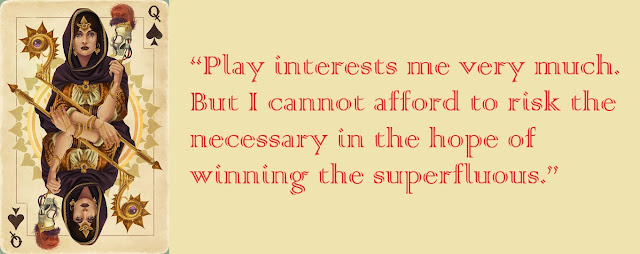The Queen of Spades has been described as a horror fantasy, supernatural drama and ghost story. It has elements of all three. My preference, and elaboration, would be an early 19th century ghost story grounded in a much stylised Russian realism.
🔽
As well as genre teasing The Queen of Spades has been generally viewed as resembling a Powell and Pressburger film. Indeed when a very young Martin Scorsese watched the film he muddled it up in his head with his love of P&P. Admittedly The Queen of Spades, and especially in the second half, does have the energetic physical pace of P&P but for me the biggest influences on the film are the grand designs of Sergei Eisenstein and the opulence of Josef Von Sternberg (Was Dickinson an admirer of The Scarlet Empress?)
The film is adapted from an 1834 story by Alexander Pushkin and as far as I know was Pushkin’s only prose venture into the supernatural and like the film only becomes so later on in the narrative. Both the film and the story tackle themes of class, avarice, friendship and romantic love: before something horrid goes bump in the night to alter the fates of all concerned.
Captain Herman Suvorin (Anton Walbrook) is a Russian officer of the engineers in St Petersburg in 1806. Unlike his fellow officers and gamblers, Herman is acutely aware of his class status: compared to the privileged colleagues around him he will struggle for years to get promotion. He frequents gambling rooms where officers play a card game called faro. Herman learns of the ancient Countess Ranevskaya (Edith Evans) who knows the numerical secret for winning at faro.
Herman purchases a book called The Strange Secrets of the Count de Saint German, concerning people who sold their souls for wealth and power, which greatly impresses him. Countess Ranevskaya has a young ward Lizavyeta Ivanovna (Yvonne Mitchell) so Herman begins to write passionate love letters to Lizavyeta as a means to entering her house and persuading Ranevskaya to tell him the playing card secret. Herman threatens the countess with an unloaded pistol and she dies of fright.
Lizavyeta is appalled at being used in order to get at Ranevskaya. Gradually the couple become the catalyst for a visitation by the invisible ghost of the old countess.
Anton Walbrook superbly conveys his perceived humiliations with a twitchy nervousness and his money scheming machinations have a brooding power. His remarkable performance is only equalled by the screen debut of Edith Evans, supposed to be aged 100 and wearing an enormous upright wig to make her look like a grand dame crossed with a mummy/monster, who moans and snaps at everyone. Sandwiched between them we have the delicate low key acting of Yvonne Mitchell as the virginal love-struck Lizavyeta.
There are horror/supernatural films where the ghost is never shown but suggested. The Haunting (1963) has the menacing sounds of an old house, The Uninvited (1944) keeps ghosts in the shadows and The Queen of Spades has some of the most powerful hidden presence moments in cinema: the sound design of a mysterious wind, banging doors and Ranevskaya’s eerie whispering, of the three winning cards and request that Herman must marry Lizavyeta, are minimal, sufficient and highly effective.
Yet the cleverness of Thorold Dickinson’s direction also plays with the haunting idea that the presence of the living Ranevskaya is already a weird ghostly implant that attracts and repels. For me this haunting creature begins to spook her ward and murderer before the act of murder itself.
I love the placement of mirrors in scenes of high anxiety and unease as reflections of the main characters are underlined by the music of Georges Auric. And though more of a ghost than horror tale, the scene where the dead Ranevskya, lying in a coffin in the church, suddenly opens her eyes at Herman is a great horror picture moment that jolted me as much as the awakening of the dead sister in Bergman’s Cries and Whispers.
The atmosphere of Dickinson’s Russia is brilliantly created in a small English film set located next to a railway station! This allows Dickinson’s camera to fluidly journey through an amazing set designed by Oliver Messel that’s strikingly photographed by Otto Heller and recalls the look of German silent cinema. And throughout The Queen of Spades its visuals are truly vivid on this 4K restoration from the film’s original nitrate negative.
Perhaps the pace of the first half of the film is a little too leisurely and occasionally muffled – the wild, would-be orgiastic scenes in the gambling room are spoilt by the actress playing the seductive gypsy singer. She’s more flattened-out Hollywood than earthy European. And Ronald Howard as Andrei, Lizavyeta’s true lover, is a little wooden. But so much of The Queen of Spades remains genuinely thrilling. It’s an incisive melodrama with an irresistible Gothic flavour. How can you resist?
“Play interests me very much. But I cannot afford to risk the necessary in the hope of winning the superfluous.”
That’s Herman, at the opening of the film, when asked why he comes every night yet doesn’t play at cards. This is his arrogance with a need to hit back; obtain a playing card system and hence a great fortune (the necessary) that instantly grabbed me. Once more I was drawn in and hooked by the haunting power of The Queen of Spades.
- Alan Price



No comments:
Post a Comment